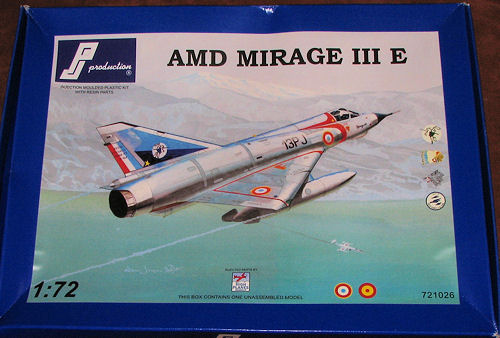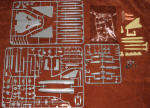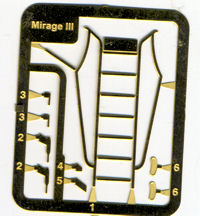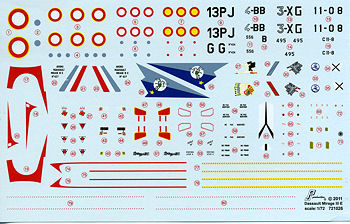
| KIT #: | 721026 |
| PRICE: | $29.50 from PJ Production |
| DECALS: | Four options |
| REVIEWER: | Scott Van Aken |
| NOTES: | Injected kit with resin and photo etch parts |

| HISTORY |
While the Mirage IIIC was being put into production, Dassault was also considering a multirole/strike variant of the aircraft, which eventually materialized as the Mirage IIIE. The first of three prototypes flew on 1 April 1961.
The Mirage IIIE differed from the IIIC interceptor most obviously in having a 30 cm (11.8 in) forward fuselage extension to increase the size of the avionics bay behind the cockpit. The stretch also helped increase fuel capacity, as the Mirage IIIC had marginal range and improvements were needed. The stretch was small and hard to notice, but the clue is that the bottom edge of the canopy on a Mirage IIIE ends directly above the top lip of the air intake, while on the IIIC it ends visibly back of the lip.
Many Mirage IIIE variants were also fitted with a Marconi continuous-wave Doppler navigation radar radome on the bottom of the fuselage, under the cockpit. However, while no IIICs had this feature, it was not universal on all variants of the IIIE. A similar inconsistent variation in Mirage fighter versions was the presence or absence of an HF antenna that was fitted as a forward extension to the vertical tailplane. On some Mirages, the leading edge of the tailplane was a straight line, while on those with the HF antenna the leading edge had a sloping extension forward. The extension appears to have been generally standard on production Mirage IIIAs and Mirage IIICs, but only appeared in some of the export versions of the Mirage IIIE.
The IIIE featured Thomson-CSF Cyrano II dual mode air / ground radar; a radar warning receiver (RWR) system with the antennas mounted in the vertical tailplane; and an Atar 09C engine, with a petal-style variable exhaust.
The first production Mirage IIIE was delivered to the AdA in January 1964, and a total of 192 were eventually delivered to that service.
Total production of the Mirage IIIE, including exports, was substantially larger than that of the Mirage IIIC, including exports, totaling 523 aircraft. In the mid-1960s one Mirage IIIE was fitted with the improved SNECMA Atar 09K-6 turbojet for trials, and given the confusing designation of Mirage IIIC2.
| THE KIT |
 For years PJ Production has been well known for its superb resin kits. Now, in conjunction with High Planes models, PJ Production has offered its first multi-media kit that is basically injected styrene.
For years PJ Production has been well known for its superb resin kits. Now, in conjunction with High Planes models, PJ Production has offered its first multi-media kit that is basically injected styrene.
It only makes sense that their first kit is of a subject that has been previously released in resin, the Mirage. In this case, it is the Mirage IIIE, probably the most popular version of the Mirage III/V family and a type bought by a number of nations around the world. This particular kit is for what you might call the base Mirage IIIE as operated by the French.
It is pretty obvious when looking at the sprues that these are intended for all the different Mirage versions. You get a bunch of different noses and different fuel tanks along with other bits and pieces like a fin fillet radio antenna not used on the versions kitted.
The injected parts are actually rather well done. The engraving is a tad on the 'soft' side compared to Hasegawa, for example, but is still quite acceptable to the majority of modelers. The wings are pretty standard as Mirage kits go and the fin is a separate item. Also separate is the forward fuselage. This is to allow the two seat version to be kitted later. The clear sprue includes both the two seat canopy as well as two windscreens; one of them unframed.
 Of course, there is resin. I have taken the liberty of using the previous Mirage 5 sprue as there are few new parts. The clear recce noses are not included nor are the skinny drop tanks or later Martin Baker bang seat. What is added to the resin fit is the lower fuselage doppler radar bulge, that is also included in plastic if you want to use that. Also in resin are standard set of drop tanks with separate fins and a replacement resin fin. A photo etch fret includes a boarding ladder, sensors, antennas and canopy mirrors.
Of course, there is resin. I have taken the liberty of using the previous Mirage 5 sprue as there are few new parts. The clear recce noses are not included nor are the skinny drop tanks or later Martin Baker bang seat. What is added to the resin fit is the lower fuselage doppler radar bulge, that is also included in plastic if you want to use that. Also in resin are standard set of drop tanks with separate fins and a replacement resin fin. A photo etch fret includes a boarding ladder, sensors, antennas and canopy mirrors.
Instructions are quite well drawn and let you know which of the optional bits are to be used for which set of markings. Color information is also provided during the build. There are four markings options, three of them in the disruptive scheme of green and grey uppers with painted aluminum undersides. However, the first option is in overall unpainted metal.
 This first aircraft is one that was with EC 2/13 in 1966 and is shown on the box art. It has the rudder stripes and intake flashes along with a very colorful unit fin marking. These folks later turned to the Mirage 5F. Another is from EC 2/4 in 1979 with the stork and indian head markings on the fin from 1979 and with the yellow surround to the insignia. The third French option is with EC 3/3 and has the smaller insignia without the yellow surround. I believe EC 3/3 was the last French operator of the type and this one is as shown in 1991. The fourth option is for the Spanish Air Force in 1992 with Ala 11.
This first aircraft is one that was with EC 2/13 in 1966 and is shown on the box art. It has the rudder stripes and intake flashes along with a very colorful unit fin marking. These folks later turned to the Mirage 5F. Another is from EC 2/4 in 1979 with the stork and indian head markings on the fin from 1979 and with the yellow surround to the insignia. The third French option is with EC 3/3 and has the smaller insignia without the yellow surround. I believe EC 3/3 was the last French operator of the type and this one is as shown in 1991. The fourth option is for the Spanish Air Force in 1992 with Ala 11.
The camo and markings sheet is in full color and the decal sheet is superbly printed with all the various data markings. The roundels have separate centers to prevent issues with registration.
| CONCLUSIONS |
If you like the Mirage III/V as do I and have been waiting for a modern injected kit, then this is a very good one, especially with all the resin and the photoetch adding just that much more detail and being something you do not have to buy later.
| REFERENCES |
November 2012
Thanks to PJ Production for the preview kit. You can find this kit at this link.
If you would like your product reviewed fairly and fairly quickly, please contactthe editor or see other details in the